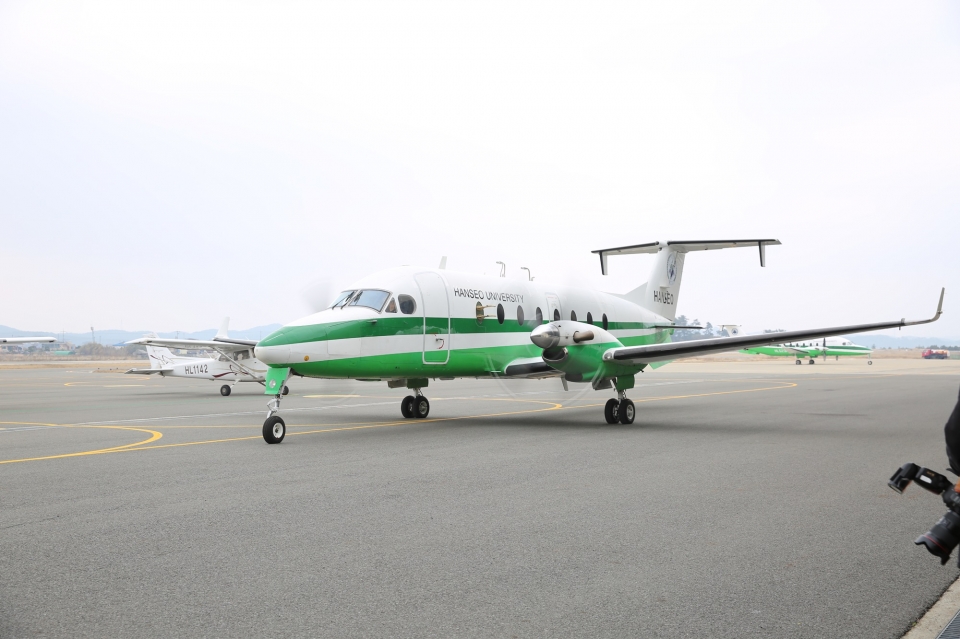Tracing South Korea’s Fine Dust Problem using a Modified Beechcraft 1900D
The South Korean government is working with Hanseo University to trace the origins of the country’s fine dust problem using a modified Beechcraft 1900D turboprop.
Dr Kim Jong-Ho, a vice president at the university and one of the project leads, tells Smart Aviation APAC that fine dust pollution is a major public health issue in South Korea that is still not yet well-understood. Fine dust, typically referring to particulate matter smaller than 2.5 micrometres in diameter (PM2.5), is dangerous to human health as it is small enough to penetrate and damage the alveoli, or air sacs in the lungs.
“Ground observation is limited to being able to determine air quality at a specific place or time on the ground. With aerial observation from an aircraft, we can fly over the western sea [the Yellow Sea] and over local pollution sources, making direct comparisons between domestic and
foreign contributions of PM2.5 pollution,” Kim says.
Local reports have blamed much of the fine dust pollution on Chinese industry across the Yellow Sea.
“We have onboard aerosol mass spectrometry (HR-ToF-AMS and UHSAS) and single-particle soot photometers (SP2) to measure PM2.5, but also analysers and equipment such as a proton-mass-transfer mass spectrometer (HR-PTR-MS), which can measure various gaseous substances. Measuring gaseous components such as nitrates and sulfates is crucial in our observation as they are often the precursors to fine dust creation,” he adds.
Kim says using an observation aircraft is also important because it allows the researchers to accurately assess the impact of larger pollution sources such as power plants and steel mills on air quality. By looking from above, they are also able to suggest directions to improve air quality, such as having industrial plants manage discharge facilities in a different way, he adds.
“We have also used a Beechcraft King Air C90GT for aerial observation, but found that the payload of the eight-seater aircraft was limiting the equipment and number of researchers we could have onboard. Switching to the 19-seat Beechcraft 1900D gave us the freedom to measure more air pollution components simultaneously,” Kim says.
However, modifying the Beechcraft 1900D to have more equipment onboard presented new challenges, Kim says. The Hanseo University aviation team spent a lot of time remodeling the pressurised aircraft according to safety guidelines and having the appropriate parts fabricated to specification, he adds.
Kim says the research team hopes to fully utilise the observation platform before considering an aircraft that can take more equipment. Between researchers from Hanseo University and partner institutes such as the National Institute of Environmental Research, there are still a number of air pollution projects in the pipeline, he adds.
These include trying to identify more distant sources of fine dust pollution and better understanding their local impacts, Kim says. There are also a number of applications in the fields of agricultural and maritime research, although there are no specific plans in those areas yet, he adds.
These include trying to identify more distant sources of fine dust pollution and better understanding their local impacts, Kim says. There are also a number of applications in the fields of agricultural and maritime research, although there are no specific plans in those areas yet, he adds.
Korean translation of article
개조된 비치크래프트 1900로
국내 미세먼지 문제 추적에 들어가다
대한민국 정부가 한서대학교와 손잡고 비치크래프트 1900D 터보프롭기를 개조하여 미세먼지의 원인을 확인하기 위한 관측에 들어갔다.
한서대학교의 선임교수이자 이번 프로젝트의 책임을 맡은 김종호 교수는 Smart Aviation APAC과의 인터뷰에서 미세먼지 문제가 국가 주요 환경 문제임에도 불구하고 정확한 사인이 밝혀지지 않았다고 말했다. 미세먼지는 가로 지름 2,5mm보다 작은 사이즈의 입자성 물질로 폐에 있는 고엽이나 공기 주머니를 침투하여 손상시킬 수 있을정도로 작다.
“지상관찰은 지상의 특정 장소나 시간에 대기질을 결정할 수 있는 것으로 한정되어 있다. 하지만 항공기를 사용하여 항공 관측으로 서해와 지역 오염원을 비행할 수 있어 국내와 해외 PM2.5 오염의 기여도를 직접 비교할 수 있다”고 김종호 교수는 말했다.
국내 보고서들은 미세먼지 오염의 많은 부분을 황해 전역의 중국 산업의 영향이라고 말한다.
“PM2.5를 측정하기 위해 기내질량분석기 (HR-ToF-AMS, UHSAS)와 단입자 그을음광도계 (SP2)를 탑재하고 있으며, 다양한 기체 물질을 측정할 수 있는 양성자-질량전달 질량분석기 (HR-PTR-MS)와 같은 분석기와 장비도 갖추고 있다”며 “질산염과 황산염 같은 기체 성분을 측정하는 것은 미세먼지 발생의 전조가 되는 경우가 많기 때문에 우리의 관측에 매우 중요하다”고 덧붙였다.
김 교수는 관측 항공기를 이용하는 것은 연구원들이 발전소나 제철소와 같은 더 큰 오염원이 대기 질에 미치는 영향을 정확하게 평가할 수 있어 매우 중요한 부분이라고 말했다. 상공에서 살펴봄으로써 산업용 발전소가 배출시설을 다른 방식으로 관리하도록 하는 등 대기질 개선 방향을 제시할 수 있다고 그는 덧붙였다.
“우리는 또한 공중 관측에 비크래프트 킹 에어 C90GT를 사용했지만, 8인승 항공기의 탑재량이 우리가 탑승할 수 있는 장비와 연구원 수를 제한하고 있다는 것을 발견했다. 19인승 Beechcraft 1900D로 전환함으로써 우리는 더 많은 대기 오염 요소를 동시에 측정할 수 있는 자유를 얻게 되었다.”라고 김교수는 말했다.
그러나 더 많은 장비를 탑재하기 위해 1900D 비크래프트를 개조하는
것은 새로운 도전이라고 김교수는 말했다. “한서대 항공팀은 가압된 항공기를 안전지침에 따라 개조하고 적절한 부품을 규격에 맞게 제작하는 데 많은 시간을
보냈다”고 그는 덧붙였다.
김 교수는 또한 연구팀이 더 많은 장비를 사용할 수 있는 항공기를
고려하기 전에 관측 플랫폼을 충분히 활용하기를 희망하고 있다며
“한서대 연구원과 국립환경과학원 등 협력기관 사이에 송유관 내 대기오염
프로젝트가 여전히 많이 남아 있다”고 덧붙였다.
“미세먼지 오염의 더 먼 원천을 파악하고 그 지역적 영향을 더 잘 이해하려는
노력도 여기에 포함된다. 농수산물 연구 분야에도 많은 신청이 있지만 아직 구체적인 계획은 없다”고 설명했다.
“미세먼지 오염의 더 먼 원천을 파악하고 그 지역적 영향을 더 잘 이해하려는
노력도 여기에 포함된다”고 말했다. “농수산물 연구 분야에도 많은 신청이 있지만 아직 구체적인 계획은 없다”고 인터뷰를 마무리
했다.

